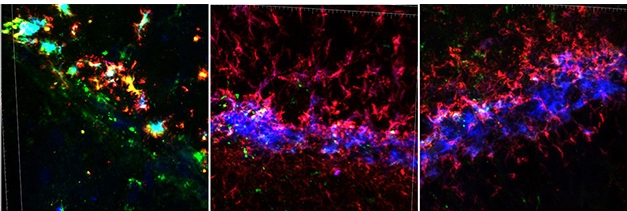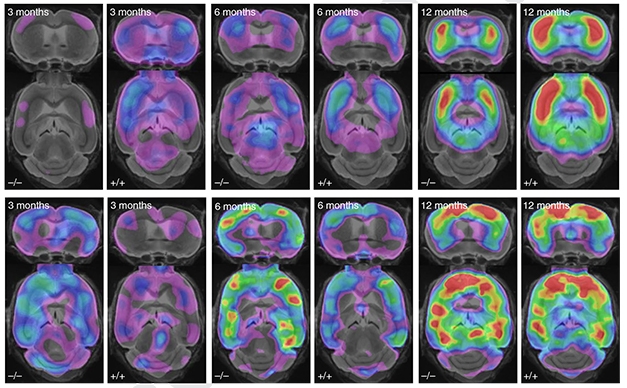Without TREM2, Plaques Grow Fast in Mice, Have Less ApoE
Quick Links
A paper in the January 7 Nature Neuroscience reports that in mice lacking TREM2, Aβ extracts seed new plaques faster than they do in control mice. Scientists led by Christian Haass, Ludwig-Maximilians University, Munich, and Melanie Meyer-Lühmann University of Freiburg, Germany, found that fewer microglia surround these dynamic plaques, and that they subsume only half as much ApoE as normal. ApoE is a major component of amyloid plaques.
- Functional TREM2 allows microglia to surround nascent plaques.
- Without TREM2, microglia clear fewer plaques and infuse them with less ApoE.
- The results suggest microglia are a major source of ApoE in the brain.
The results support the idea that TREM2 helps microglia clear amyloid early in disease, and that without the receptor, plaques spread more readily. The work also pins microglia as an important source of plaque ApoE. Alzforum covered these findings when they were presented at the joint Keystone symposia Advances in Neurodegenerative Disease Research and Therapy/New Frontiers in Neuroinflammation, held last June in Keystone, Colorado (Jul 2018 conference news).
First author Samira Parhizkar and colleagues wanted to see how TREM2 affects the earliest stages of plaque formation. They injected brain extracts from old, plaque-laden APP/PS1 donor mice into the hippocampi of young APP/PS1 mice. The recipients expressed either wild-type TREM2, no TREM2, or the TREM2T66M mutant linked to Nasu–Hakola disease and frontotemporal dementia. After six weeks, amyloid plaques had grown in all three but were bigger, more plentiful, and more diffuse in the mice lacking functional TREM2. In those, far fewer microglia surrounded plaques, which contained half the ApoE of plaques in control mice. “This was a very surprising observation, since over decades we believed that plaque-associated ApoE is derived from astrocytes,” said Haass. In fact, in APP/PS mice with wild-type TREM2, brain ApoE levels rose fivefold between three and 12 months of age, but not so in mice lacking TREM2 function.

TREM2 Puts the ApoE in Plaques. Newly seeded plaques (blue) and associated Aβ (red) are small and infused with ApoE (green) in APP/PS1 mice (left). In TREM2 knockouts (middle) or TREM2T66M mutants (right), ApoE is absent from plaques, which grow larger. [Courtesy of Parhizkar et al., 2018. Nature.]
At 12 months, controls also had more active microglia as judged by microPET using GE180, a ligand for the mitochondrial transporter TSPO. Curiously, by that time, plaque growth had slowed in the TREM2 nulls, such that they had the same plaque burden and size as control mice (see image below). The findings indicate fast accumulation of amyloid in the face of a poor microglial response in young TREM2 nulls, with some microglial activation as the mice age. “It is tempting to speculate that the later, reduced plaque growth rate is due to reduced plaque-associated ApoE, which is a major aggregation factor of Aβ,” Haass said.

Microglia versus amyloid. Mouse PET scans using the TSPO ligand (top row) GE180 or the amyloid ligand florbetaben (bottom row) show that TREM2 knockouts (-/-) have less microglial activity at three, six, and 12 months than TREM2 wild-type mice (+/+), while TREM2 -/- mice accumulate more amyloid at three and six months. [Courtesy of Parhizkar et al., 2018. Nature.]
Can any of this be seen in humans? To get a sense, Parhizkar and colleagues examined postmortem tissue from 11 AD cases. The seven who had AD-related coding variants in TREM2 also had less ApoE in their plaques, and fewer microglia surrounding the plaques, than the four with normal TREM2.
The authors hypothesize that ApoE helps compact plaques. “It appears that disease-associated microglia produce ApoE and pump it directly into the plaques, where it drives Aβ aggregation and stabilization,” said Haass. While this may seem counterintuitive for a cell that is thought to clear the brain of Aβ, it may protect neurons by corralling soluble toxic oligomers that might otherwise leech from diffuse plaques.—Gwyneth Dickey Zakaib
References
News Citations
Further Reading
Primary Papers
- Parhizkar S, Arzberger T, Brendel M, Kleinberger G, Deussing M, Focke C, Nuscher B, Xiong M, Ghasemigharagoz A, Katzmarski N, Krasemann S, Lichtenthaler SF, Müller SA, Colombo A, Monasor LS, Tahirovic S, Herms J, Willem M, Pettkus N, Butovsky O, Bartenstein P, Edbauer D, Rominger A, Ertürk A, Grathwohl SA, Neher JJ, Holtzman DM, Meyer-Luehmann M, Haass C. Loss of TREM2 function increases amyloid seeding but reduces plaque-associated ApoE. Nat Neurosci. 2019 Feb;22(2):191-204. Epub 2019 Jan 7 PubMed.
Annotate
To make an annotation you must Login or Register.

Comments
No Available Comments
Make a Comment
To make a comment you must login or register.